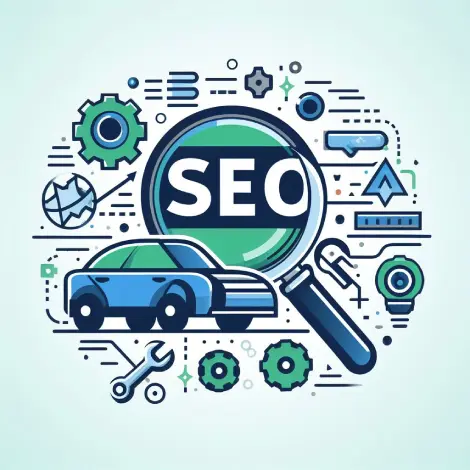Automotive SEO is an essential component of any online marketing strategy for car dealerships. It is a set of on-page optimizations and local SEO initiatives that help improve the visibility of car dealership websites on search engines. In today’s digital age, car buyers are increasingly turning to the Internet for new vehicle research.
As a result, dealerships must focus their digital efforts on attracting new customers through their websites. By optimizing their websites for search engines, dealerships can generate more qualified leads and improve their market share.
One of the best practices for improving search engine rankings is to use structured data on dealership websites. Structured data helps search engines understand the content of a website and can improve the visibility of local keywords.
This is especially important for local organizations and communities. While TV ads and costly airtime were once the norm, digital marketing has become the go-to for many dealerships. In fact, according to the CMO Survey, spending on digital marketing has surpassed that of TV ads and newspapers.
With the decline in ad spending on local news, digital media spending has become even more important for dealerships looking to improve their market share. In conclusion, Automotive SEO is a crucial aspect of any dealership’s digital marketing strategy.
By focusing on structured data usage and local SEO initiatives, dealerships can improve their search engine rankings and attract more qualified leads. As someone who has worked in the automotive industry, I have seen firsthand how effective these strategies can be in generating new business.
Table of Contents
The Unique Challenges of Automotive SEO
The automotive industry is highly competitive, and car dealerships in the United States face unique challenges when it comes to SEO. Car dealer websites must fight hard for every keyword position, especially since the automotive sector is crowded and image-heavy websites can present challenges when optimizing for site speed.
According to Google’s study, 64% of car customers are willing to buy without a test drive if they can get the same information from a video. This puts the onus on car dealers to meet that need. Car dealerships must also prioritize local optimization since people typically buy cars from their local dealerships.
To be successful, car dealerships must pay attention to their SEO strategy. Effective SEO campaigns can pay huge dividends, but they come with their fair share of obstacles. Car dealerships must focus on improving their organic search performance to increase their market share.
Overcoming the Challenges
To overcome these challenges, car dealerships must focus on improving their user experience. Car customers want information, and they want it fast. Car dealerships must provide high-quality content that is relevant to their customers’ needs. They must also embrace video as a way to provide information to their customers.
Car dealerships must also focus on site speed. Image-heavy websites can slow down site speed, which can negatively impact SEO success. Car dealerships must optimize their website for speed to ensure that their customers have a positive experience.
Finally, car dealerships must focus on local optimization. They must use local keywords, generate local backlinks, and build strong review profiles to attract local customers.
By focusing on these key areas, car dealerships can overcome the unique challenges of automotive SEO and improve their organic search performance.
12 Useful Tips for Automotive SEO

1) Using Website For Automotive SEO
The automotive industry is fiercely competitive, and with over 202 million cars on the road in the US alone, it’s crucial to have an effective SEO strategy to stay ahead of the competition. In this article, we’ll explore some tips to optimize your website for search engines and reach more customers.
Purposefully Designed and Maintained Website
Your website is the first impression that potential buyers have of your dealership. A purposefully designed and maintained website can help you rank high in Google’s search results and reach more customers. Your website should be easy to navigate, visually appealing, and provide all the necessary information that customers are looking for.
Local SEO
With the pandemic, there have been significant changes in how automotive dealers do business. Customers are now more likely to start their searches online, and local SEO can help you reach them. Make sure your website is optimized for local searches by including your address, phone number, and all the cities you serve.
Title Tag, H1, Meta Description, and Image Alt Text
Title tags, H1 tags, meta descriptions, and image alt text are all applicable to your website’s SEO. Make sure your title tag and H1 tag are relevant to the content on the page. The meta description should be a concise summary of the page’s content, and the image alt text should describe the image accurately.
Search Bar and Social Sharing Plugins
A search bar and social sharing plugins can help improve your website’s user experience. A search bar can help customers find what they’re looking for quickly, and social sharing plugins can help your content reach a broader audience.
Regularly Audit and Make Improvements
Finally, regularly audit your website and make improvements where necessary. SEO is an ongoing process, and it’s essential to keep up with the latest trends and best practices. In conclusion, optimizing your website for search engines is crucial in the automotive industry.
By following these tips, you can aim to rank higher in Google’s search results and reach more customers. Remember to keep your website purposefully designed and maintained, optimize for local SEO, use relevant title tags, H1 tags, meta descriptions, and image alt text, add a search bar and social sharing plugins, and regularly audit and make improvements.
2) Creating Unique and Valuable Content

In the automotive industry, it’s difficult to outrank competitors and reach potential customers. However, by focusing on creating fresh, relevant, and unique content, you can add value to your dealership and attract customers. In this article, we’ll explore some tips for creating useful content for automotive SEO.
Creating unique and valuable content is crucial for your digital content marketing efforts. Your content should be interesting and provide customers with new information about cars, dealerships, and the automotive industry.
Consider updating your dealership’s website with changes to your inventory, monthly specials, and routine updates to your site’s content.
Blog and News Section
Creating a blog or news section on your website is a good way to provide local content to your DMA. Your IT department or social media team can write a weekly blog post of 350-500 words on topics that your community wants to know about, such as local events, upcoming model launches, charity or fundraising opportunities, and local neighborhood news.
Remember to Steward Your Community
Remember to steward your community by providing information that is valuable to them. By focusing on creating unique and valuable content, you can add value to your dealership and attract customers.
3) Prioritize Long-Tail Keywords
In competitive and densely populated areas like major city centers, achieving first-page rankings for lucrative local keywords can be difficult. Prioritizing long-tail keywords is a way around this problem. Long-tail keywords are highly specific terms that have lower search volume than short-tail keywords. However, when added together, they make up a significant chunk of the total search volume.
Car dealers should prioritize long-tail commercial keywords that focus on specific features of individual vehicles. These keywords can be difficult to rank for, but they are more likely to attract highly qualified leads.
For example, instead of targeting a short-tail local keyword like “Ford dealer Atlanta,” focus on model-specific product pages and targets like “New Ford Mustang Atlanta” or “New Ford Explorer Atlanta.” Semrush’s Keyword Magic tool is a great way to find long-tail keywords that are relevant to your business.
Simply enter your brand of car and location, scroll through the results, and pick out the most relevant keywords for your business. On-page optimization is key to ranking for long-tail keywords, so make sure to include them in your content and meta tags.
4) Create Location-Based Pages
Creating localized pages for key car brands is an important part of the customer funnel. When a user searches for a make/model in a specific geographic area, your dealership, such as Leith Honda, should have a page that appears in the search results. This strategy can help improve your site’s search rank and overall automotive SEO.
5) Generate Local Backlinks
Backlinks are an important SEO ranking factor, and generating local backlinks can help your site rank higher in local search results. In this section, we’ll explore some tips for generating local backlinks for your automotive business.
Identify Relevant Backlink Targets
The first step in generating local backlinks is to identify relevant websites and domains that you can target. Look for websites that are relevant to your business area, such as automotive event organizers, communities, automotive publications, and newspapers. You can also look for prospects and competitors in your area and analyze their backlink sources using a Backlink Analytics tool.
Determine Relevance and Authority
Once you have a list of potential backlink sources, you need to determine their relevance and authority. Use filters such as country and active follow links to trim down the list. Export the list to a spreadsheet and use a tool to analyze the Referring Domains tab. Focus on sources that have high relevance and domain authority, as these will have the most potential to generate referral traffic and better rank in search results.
Work on Link Building Strategies
Once you have identified relevant websites and domains, it’s time to work on link-building strategies. Reach out to these sources and acquire links from them. You can also create business listings on local news publications and other relevant websites.
6) Increase the number of local organizations linking to your website
Inbound links from trusted websites can significantly improve your website’s ranking. Obtaining links from local websites and organizations can improve your site’s ability to rank highly for location-based search queries. For example, if you are a car dealership in Washington DC, local links from other car dealerships or organizations in the area can help you rank higher for location-based search queries.
Sponsorships and community events are great starting points for obtaining local links. Donating to a local children’s charity and being listed as a sponsor on the charity’s website is one way many dealerships get involved with local non-profits. Other options include sponsoring local sports teams or car meet-ups.
Obtaining mentions and links from local groups can be as simple as requesting to be acknowledged as a sponsor or participant on the organization’s website. It never hurts to ask!
7) Mine Your Analytics

Analyzing your website analytics can help you identify your most popular content, top landing pages on your site from search engines, and top website referrals, and discover which marketing efforts lead to the most conversions.
It is important to conduct a weekly review of your analytics to ensure that you are making data-driven decisions to improve your website’s performance. By understanding your website analytics, you can make informed decisions about your marketing strategy and improve your website’s overall performance.
8) Claim your Google Business page
In today’s digital age, having a strong online presence is crucial for businesses of all sizes. One of the best ways to manage your online presence is by claiming your Google Business page. This fast and easy way to claim your business listing can have a positive impact on your online traffic and make it easier for individuals to find and view your inventory.
Setting up a Google My Business account is simple. All you need to do is enter your contact details and ensure that they are listed correctly. You will also need to select the categories that best describe your business and the times you are listed as open. Once you have set up your profile, you can add a header image and description of your business.
It is important to ensure that your name, address, and phone number (NAP) are associated with your business in the same format as they appear on your website. This will help Google and other sites mentioning your business to recognize it as the same entity. By claiming your Google Business page, you can take control of your online presence and ensure that your business is accurately represented online.
In my experience, claiming your Google Business page is a crucial step in managing your online presence. It can help you attract more customers and improve your local SEO rankings. By ensuring that your business is listed correctly and that your NAP is consistent across all sites, you can help Google and other search engines recognize your business as a trusted and reliable source.
9) Build Strong Review Profiles

In the world of automotive SEO, customer reviews are a crucial factor that can make or break your local SEO rankings. According to a study, the number of positive reviews on your Google Business Profile correlates with your ranking position on Google Maps results 1. Therefore, securing a strong review profile is a significant factor in the success of your local SEO efforts.
But how do you measure the trustworthiness of your customer reviews? How do you ensure that your reviews are displayed on your product pages and affect purchase decisions? The answer lies in building strong review profiles.
A strong review profile is a collection of customer reviews that are authentic, positive, and relevant to your business. It is a measure of your trustworthiness in the eyes of your customers and search engines. Good reviews can help you rank higher in search results, attract more customers, and ultimately drive more sales.
Research shows that displaying customer reviews on your product pages can increase conversion rates by up to 270% for expensive products like vehicles 1. Therefore, building a strong review profile should be a top priority for any automotive business.
In my experience, the best way to build a strong review profile is to encourage your customers to leave positive reviews on your Google Business Profile. You can also create an infographic or graph that shows the average ratings of your business on Google Maps and other review sites like Yelp and Facebook 1. This will help you showcase your strong review profile to potential customers and boost your local SEO rankings.
Building a strong review profile is a crucial aspect of automotive SEO. By securing positive customer reviews and displaying them on your product pages, you can increase your trustworthiness, attract more customers, and ultimately drive more sales.
10) AutoDealer Schema
Integrating Schema markup into your website’s code can have a significant impact on how search engines and site crawlers interpret your content and data. By adding Schema markup to your website, you can provide search engines with more detailed information about your business, such as your phone number, new and used inventory, user reviews, and ratings on a 1 – 5 scale.
This can help your business appear in Google’s Knowledge graph, which can lead to higher user click-through rates and search rankings. For example, let’s consider a local car dealership. By adding Schema markup to their website, they can provide search engines with more detailed information about their business, such as their hours of operation, address, reviews, and telephone number.
This can help their business appear in Google’s Knowledge graph, which can lead to higher user click-through rates and search rankings. Studies have shown that businesses with Schema mark-up options on their website can rank an average of four positions higher in search results than those without 1. Therefore, adding a Schema markup to your car dealer website can have significant SEO benefits.
In my experience, the best way to add Schema markup to your website is to work with a web developer or SEO expert who can ensure that your Schema markup is correctly implemented on your website’s backend. By doing so, you can ensure that your business is accurately represented online and that you are taking advantage of all the SEO benefits that Schema markup has to offer.
11) Get Citations
Citations are a crucial factor in local SEO. They help validate your business’s name, address, and other details across other websites, which can establish credibility and trust within the community and search engines. Citations can also help your business rank highly on search engines like Google and Bing, making it easier for potential customers to find you.
The easiest way to get more citations is to list your dealership’s details on reputable business directories like the local chamber of commerce website, Facebook, and Yelp. You can also use an aggregator tool like Moz Local or Yext to push your information to a wide variety of directory sites.
This ensures that your Name, Address, and Phone number (NAP) are listed consistently across all sites. Aggregators push your information to the backend of each site, ensuring that your NAP is listed consistently across all sites. This can help improve your local SEO rankings and make it easier for potential customers to find your site.
In my experience, getting more citations is a crucial aspect of automotive SEO. By listing your dealership’s details on reputable business directories and using aggregator tools, you can ensure that your business is accurately represented online and that you are taking advantage of all the SEO benefits that citations have to offer.
12) Incorporate Video SEO Into Your Marketing Strategy
Incorporating Video SEO into your marketing strategy is essential for reaching potential customers. Car dealerships are one of the most popular categories on YouTube, which is the second largest search engine.
Videos that are properly optimized can appear in search results and studies have shown that internet users are more likely to watch a video than read a block of text. Optimizing videos for search engines can dramatically increase your chances of being seen by potential customers.
Videos are also more likely to be shared on social media, which has the potential to reach a wider audience. To improve your Car Dealer Video SEO, follow these simple tips. First, use keyword-rich and relevant keywords in your video title and description to help it rank higher in search results. Second, keep your video short, sweet, and to the point. Long, boring car commercials are a thing of the past. Aim for two minutes or less to keep your audience engaged.
Combining Paid Media with SEO in the Automotive Industry

SEO is a reliable way of building automotive website traffic. But it’s a long-term endeavor. You can use pay-per-click (PPC) to generate leads more quickly. Automotive PPC can also complement your SEO strategy. You can use it to test which keywords have the highest conversion rates and then use those keywords in your lead-generation campaign. Google Ads is a great way to manage your marketing budget and drive sales growth.
The PPC process for car dealers includes keyword research, ad copy, ad groups, target keyword clusters, and campaign customization. This includes defining geographic parameters, negative keywords, and the best time of day to serve ads.
An iterative approach to data and campaign performance can help you refine your campaigns over time and improve your location-based search rankings on Google Ads.
Frequently Asked Questions
What does SEO mean on a car?
Automotive SEO involves applying search engine optimization strategies to car dealer websites. The goal is to enhance the visibility of the website in organic searches, draw in more visitors, and ultimately boost sales. While the process shares similarities with SEO in other industries, Automotive SEO specifically targets optimization for individuals actively searching for a car.
What is the SEO strategy for the automotive industry?
Here are some user-friendly and distinctive SEO tactics tailored for the automotive industry:
- Explore and incorporate relevant keywords that boost business and attract traffic.
- Craft valuable, top-notch content for your website pages.
- Enhance your site by incorporating effective links.
- Consistently gauge the outcomes of your SEO initiatives.
Conclusion
In today’s digital age, local car dealership efforts must focus on digital marketing strategies to survive. The future of the automotive industry is digital, and dealerships must adapt to stay ahead of the competition. Dealership survival in the digital age requires a team that is well-versed in local automotive SEO strategies.
Hiring an SEO company or building an in-house team can be expensive, but it is essential to move forward. Consistent updating of an outdated website is crucial to building trust signals and ensuring a successful digital focus.
In conclusion, local automotive SEO strategies are essential for the success of any dealership. Overnight success is not possible, but with time and a consistent strategy, dealerships can push forward. If you cannot afford to hire help, focus on consistent updating of your outdated website and building up trust signals. Do not let outdated information hold you back from achieving your goals.
